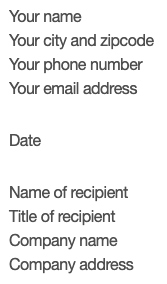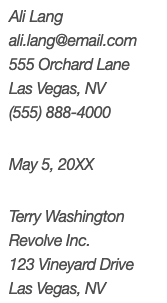Cover Letter Tutorial
When optional, submitting a cover letter is also a great way to go above and beyond to show the employer you are genuinely interested in the job.
The key to writing effective cover letters is to succinctly communicate how your professional experience fits the needs of the role and culture of the company.
What is a cover letter?
A cover letter, also known as an application letter, is a three- to four-paragraph memo to employers that explains your interest in the job and company as well as your fitness for the role.
- It is typically submitted along with your resume in a job application.
- This letter should highlights your skills, experience and achievements in relation to the position you’re applying for.
- Unlike your resume, cover letters allow you to go into more detail about your professional career and explain why you’re a good candidate.fit for the role and company.
A well-written cover letter has the potential to impress employers and set you apart from other applicants. To avoid a generic cover letter, you should conduct in-depth research on the company and role for which you’re applying to in-depth before writing your cover letter.
Cover letter format
- A cover letter should be formatted like a business letter and include the following sections:
- Header with date and contact information
- Salutation or greeting
- Opening paragraph
- Middle paragraph(s)
- Closing paragraph
- Letter ending and signature
- Your cover letter should be one page in length and use a simple, professional font, such as Arial or Helvetica, 10 to 12 points in size.
- Your letter should be left-aligned with single spacing one-inch margins.

Cover letter sample
How to write a cover letter?
Here are six simple steps to write a great cover letter:
- Start with your header
- Include a greeting
- Write an opening paragraph
- Follow with a middle paragraph
- Finish with a closing paragraph
- End with a professional sign off
1. Start with your header
Include a few pieces of personal and role specific information at the top of your cover letter.
This section should include your contact information, date of application and recipient’s contact information.
Including a professional and detailed heading will make it easier for the hiring manager or recruiter to follow up with you regarding the position.
Template

cover_letter_header_template
Example

cover_letter_header_example
2. Include a greeting
Try to find the name of the person who will be reviewing applications for the job
Address your letter to this person with a common business greeting, such as “Dear” or “Hello.”
If you’re unable to find the preferred gender pronouns (she/her, them/they), it is best to use a gender-neutral greeting such as “Dear first and last name” or “Dear position title”.
Example
- Dear Hiring Manager,
- Hello Ms. Wallace,
- Dear Tyler Wallace,
3. Write an opening paragraph
Mention the job title for which you’re applying and where you saw the position posting.
Explain your specific interest in the role and company so the reader knows you’ve done your research and have genuine interest.
Briefly state the main experience or qualification you have that makes you a good fit.
Example
I’m excited to apply for the Graphic Designer position at Cloud Clearwater I found on Indeed. I understand you’re currently adding several new product lines, and I believe my skills in video and animation provide a significant advantage for creating a successful launch. As a longtime fan of your products, I’m thrilled at the opportunity to bring my unique style and passion for beachwear to the company.
4. Follow with a second paragraph
Your second paragraph should be a brief overview of your background as is relevant to the position.
- Include key achievements, skills and specialties that make you particularly suited to perform well in the position.
- Focus on one or two and provide specific details about your success including measurable impacts you made.
Pay close attention to keywords listed in the job description and include those that you identify with in the body of your cover letter.
You should only include information about your most recent one or two professional experiences.
Tell story with STAR method
Example
As the Director of Human Resources at Wes Morgan Philips, I was a key senior leader in the organization and was responsible for improving the efficiency and performance of the company’s 540 employees. Before that, I worked in human resources, equal employment opportunity and diversity for Jenkins Technology Solutions, Inc. At Jenkins Technology Solutions Inc., I developed an employee retention plan that involved the creation of a wellness program, an internal training program and a promotions selection process, which led to a 50% reduction in the overall employee turnover rate.
5. Finish with a closing paragraph
The next paragraph should focus on another key achievement or skill that is relevant to the position. Instead of repeating details from your resume, expand on specific stories or anecdotes that display your fitness for the role. Again, focus on stories that demonstrate the skills and qualifications outlined in the job description.
Example
Achieving ambitious marketing goals is always a top priority, and I am always looking out for the best interests of the company. I enjoy delivering marketing presentations to potential clients and focusing on the strengths of an organization. My marketing skills at River Tech enabled the company to experience new levels of success and a 45% increase in customer engagement. I am never satisfied with the status quo, and I believe that a company should continually look for ways to improve and reach new clients through innovative campaigns.
6. End with a professional signoff
End your cover letter with a paragraph that summarizes the reasons you are applying for the role and why you would be a great fit
Keep the cover letter conclusion brief and explain that you look forward to hearing from the employer with the next steps.
End with your signature at the bottom.
Example
Thank you for your time and consideration. I’m looking forward to learning more details about the Sales position and about TradeLot. Growth is essential to my continued success, and I’m excited for the chance to be a part of TradeLot’s industry-leading team. My proven track record and TradeLot’s quality products are a winning combination for increasing the company’s market share.
Sincerely,
Malik Rabb
Tips
Customize your header based on your application format
- If you’re writing your cover letter directly within an online job application, there’s no need to include your address or other contact information, as you’ve probably already typed that into other areas of the application form.
- If you’re including your cover letter as an attachment, you can use the same heading as your resume.
Avoid generic references to your abilities
- Whenever possible, tell meaningful anecdotes that tie your skills to concrete problem-solving activities or tangible business results you’ve worked on in your career.
- To make an impact, you need to show hiring managers examples of your skills in action.
Keep it short and to the point
- Focus on the details that are most important for the job.
- Read the job description closely to identify the best opportunities to illustrate your qualifications.
- Choose one or two of your professional achievements that you are proudest of and directly map them to the desired experience or qualifications the hiring manager is looking for, using just a few detailed but concise sentences.
- Don’t reiterate everything that’s on your resume. You want to focus on one or two anecdotes, expanding on how you achieved something specific.
Proofread before you submit
- Reread your cover letter several times before submitting it and keep an eye out for errors of spelling, grammar or punctuation.
- Reading the letter aloud can help you pick out awkward phrasing or too-long sentences. There are certain common errors that we all tend to gloss over, so make sure to do a slow, deliberate reading that examines each word.
- If your salutation includes the hiring manager’s name, triple-check the spelling.
Others
- If sending electronically, put the text in the body of the email rather than as an attachment, to avoid it being detected by spam filters.
- Only mention your current salary or salary expectations if the employer has specifically asked you to do so in the job description.
- If you’re asked to include this information put it between the third and last paragraphs.
- Save with a .PDF file extension to make sure it can be opened and read on any machine (unless the job advert states differently).
References
- How To Write a Cover Letter (Plus Tips and Examples): Tutorials from Indeed
- Resume and Cover Letter Writing: Tutorials from Berkeley Career Center